
28
GENERAL EMC - HARMONICS - MAINS INTERFERENCE
POWERDRIVE MD2CS Installation guide
4946 - 2017.12 / c
en
4 - GENERAL EMC - HARMONICS -
MAINS INTERFERENCE
The power structure of frequency inverters leads to the
occurrence of two types of phenomenom :
- Low-frequency harmonics fed back to the mains supply
- Emission of radio-frequency signals (RFI)
These are independent phenomena. They have different
consequences on the electrical environment.
4.1 - Low-frequency harmonics
The rectifier, at the head of the frequency inverter, generates
a non-sinusoidal AC line current.
3-phase rectifier line current consumption.
This current carries harmonics with number 6n ± 1.
Their amplitudes depend on the impedance of the mains
supply upstream the rectifier bridge, and on the structure
of the DC bus downstream the rectifier bridge.
The more inductive the mains supply and the DC bus, the
more these harmonics are reduced.
They only affect the quality of the mains supply for loads on
frequency inverters of several hundred kVA, if these loads
represent more than a quarter of the total load on a site.
In the above conditions:
• These harmonics have virtually no effect on the electrical
energy consumption level.
• The associated temperature rises in transformers and
motors directly connected to the mains supply are negligible.
It is very rare for these low-frequency harmonics to cause
interference on sensitive equipment.
4.2 - Radio-frequency interference:
Immunity
4.2.1 - General
The immunity level of a device is defined by its ability to
operate in an environment which is contaminated by external
elements or by its electrical connections.
4.2.2 - Standards
Each device must undergo a series of standard tests
(European standards) and meet a minimum requirement in
order to be declared as compliant with the variable speed
drive standards (EN 61800-3).
4.2.3 - Recommendations
An installation consisting exclusively of devices which comply
with the standards concerning immunity is very unlikely to be
subject to a risk of interference.
4.3 - Radio-frequency interference:
Emission
4.3.1 - General
In order to limit motor losses and obtain a low level of
motor noise, frequency inverters use high-speed switches
(transistors, semi-conductors) which switch high voltages
(> 550 V) at high frequencies (several kHz).
As a result, they generate radio-frequency (R.F.) signals
which may disturb operation of other equipments or distort
measurements taken by sensors:
• Due to high-frequency leakage currents which escape
to earth via the stray capacity of the drive/motor cable and
through the motor via the metal structures which support it.
• By conduction or feedback of R.F. signals on the power
supply cable: conducted emissions
• By direct radiation near to the mains supply power cable
or the drive/motor cable: radiated emissions.
These phenomena are of direct interest to the user.
The frequency range concerned (radio frequency) does not
affect the energy distribution company.
4.3.2 - Standards
Standard EN 61800-3 defines the maximum emission levels
to comply with according to the type of environment the drive
is installed in. In some cases, it may be necessary to add an
external RFI filter (see section 4.6).
















































